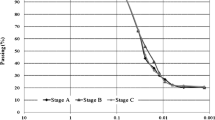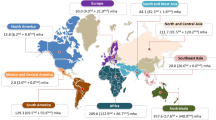Abstract
In order to evaluate the electrokinetic process for unsaturated soil with different compacted conditions, six remolded soil samples containing the same water content (16 wt%) were compressed to obtain the various degrees of compaction (96.87% to 103.37%). All the lab-scale experiments were performed by applying a constant electrical voltage (1 V/cm). The electrical parameters related to the electrokinetic process were monitored to evaluate the influence of the soil degree of compaction on this process. The obtained results indicate that the soil compaction degree could influence the electrical current, the migration velocity of the voltage front, and the controlling mechanism of water transport during the electrokinetic processes. Followed by the initial decline, the electrical current of soil with a lower degree of compaction (96.87%) would increase at 0.7 mA/h, which was about seven times larger than that of the soil with a higher degree of compaction (103.37%). The migration velocity of voltage front in the soils increased with decreasing compaction degree. The voltage front migrated from the cathode towards the anode at 6.66 mm/h in the soil with a lower degree of compaction (96.87%). In comparison, the migration velocity decreased to 1.75 mm/h in the soil with a higher degree of compaction (103.37%). Both hydraulic and electrokinetic driving forces could influence the water transport in unsaturated soil. The results demonstrate that the catholyte entering the soil under the hydraulic gradient could be opposite to electro-osmosis. The electrokinetic driving force would be a major controlling mechanism for the unsaturated soil with a higher degree of compaction. For the soil with a lower degree of compaction, the hydraulic driving force would affect the water transport in the soil during its initial saturation period. Moreover, with the increase in soil saturation, the effects of hydraulic driving force were weakened, and the electrochemical properties of the pore solution appeared to be the dominant factor for the electrokinetic process.
Similar content being viewed by others
References
K. R. Reddy and R. E. Saichek, J. Environ. Eng., 129, 336 (2003).
P. V. Sivapullaiah and B. S. N. Prakash, J. Hazard. Mater., 143, 682 (2007).
B. G. Ryu, S. W. Park, K. Baek and J. S. Yang, Sep. Sci. Technol., 44, 2421 (2009).
K. R. Reddy, C. Cameselle and P. Ala, J. Appl. Electrochem., 40, 1269 (2010).
C. Tamagnini, C. Jommi and F. Cattaneo, An. Acad Bras Cienc., 82, 169 (2010).
M. Razaee and G. Asadollahfardi, Environ. Model. Assess., 24, 235 (2019).
Y. B. Acar, R. J. Gale, A. N. Alshawabkeh, R. E. Marks, S. Puppala, M. Bricka and R. Parker, J. Hazard. Mater., 40, 117 (1995).
A. T. Yeung, Cn. Hsu and R. M. Menon, J. Hazard. Mater., 55, 221 (1997).
A. T. Yeung and Cn. Hsu, J. Environ. Eng., 131, 298 (2005).
R. T. Gill, M. J. Harbottle, J. W. N. Smith and S. F. Thornton, Chemosphere, 107, 31 (2014).
R. López-Vizcaíno, C. Risco, J. Isidro, S. Rodrigo, C. Saez, P. Pañizares, V. Navarro and M. A. Rodrigo, Chemosphere, 166, 540 (2017).
R. López-Vizcaíno, C. Risco, J. Isidro, S. Rodrigo, C. Saez, P. Pañizares, V. Navarro and M. A. Rodrigo, Chemosphere, 166, 549 (2017).
M. Vocciante, A. Caretta, L. Bua, R. Bagatin and S. Ferro, Chem. Eng. J., 289, 123 (2016).
Y. Liu, L. Zheng and S. Rao, Adv. Mater. Sci. Eng., 2021, 6642785 (2021).
X. Li, L. Wang, X. Sun and Y. Cong, Front. Struct. Civ. Eng., 13, 1463 (2019).
C. D. Cox, M. A. Shoesmith and M. M. Ghosh, Environ. Sci. Technol., 30, 1933 (1996).
A. Saini, D. N. Bekele, S. Chadalavada, C. Fang and R. Naidu, Environ. Technol. Inno., 23, 101585 (2021).
Q. Lu, Chemosphere, 254, 126861 (2020).
R. Ghobadi, A. Altaee, J. L. Zhou, E. Karbassiyazdi and N. Ganbat, Sci. Total Environ., 794, 148668 (2021).
R. Sun, W. Gong, Y. Chen, J. Hong and Y. Wang, Process Saf. Environ., 153, 117 (2021).
ASTM D4186/D4186M-20e1 (2020). Standard Test Method for One-Dimensional Consolidation Properties of Saturated Cohesive Soils Using Controlled-Strain Loading. ASTM International, West Conshohocken, PA.
ASTM D698-12 (2021). Standard Test Methods for Laboratory Compaction of Soil Standard Effort (12,400 ft-lbf/ft3 (600kN-m/m3)). ASTM International, West Conshohocken, PA.
ASTM D1557-12 (2021). Standard Test Methods for Laboratory Compaction Characteristics of Soil Using Modified Effort (56,000 ft-lbf/ft3 (2,700 kN-m/m3)), ASTM International, West Conshohocken, PA.
S. Kowalczyk, M. Maślakowski and P. Tucholka, J. Appl. Geophys, 110, 43 (2014).
J. Lipiec, M. Hajnos and R. Świeboda, Geoderma, 179–180, 20 (2012).
Y. B. Acar and A. N. Alshawabkeh, Environ. Sci. Technol., 27, 2638 (1993).
K. Tang, F. Zhang, D. Feng and X. Lu, Eng. Geol., 294, 106404 (2021).
Á. Yustres, R. López-Vizcaíno, V. Cabrera and V. Navarro, E3S Web of Conferences, 195, 02003 (2020).
E. D. Mattson, R. S. Bowman and E. R. Lindgren, J. Contam Hydrol., 54, 99 (2002).
Á. Yustres, R. López-Vizcaíno, C. Sáez, P. Cañizares, M. A. Rodrigo and V. Navarro, Sep. Purif. Technol., 192, 196 (2018).
X. Y. Xie, Y. M. Liu and L. W. Zheng, 2018. Mar. Georesour. Geotec., 37, 1188 (2019).
ASTM D4318-17e1 (2017). Standard Test Methods for Liquid Limit, Plastic Limit, and Plasticity Index of Soils, ASTM International, West Conshohocken, PA.
ASTM D854-14 (2014). Standard Test Methods for Specific Gravity of Soil Solids by Water Pycnometer, ASTM International, West Conshohocken, PA.
ASTM D7503-18 (2018). Standard Test Method for Measuring the Exchange Complex and Cation Exchange Capacity of Inorganic Fine-Grained Soils, ASTM International, West Conshohocken, PA.
A. F. Huweg, Ph.D Thesis, University of Southern Queensland, Queensland (2013).
ASTM G57-06 (2012). Standard Test Methods for Field Measurement of Soil Resistivity Using the Wenner Four-Electrode Method. ASTM International, West Conshohocken, PA.
A. T. Yeung, Cn. Hsu and R. M. Menon, J. Geotech. Geoenviron., 122, 666 (1996).
A. Z. Al-Hamdan and K. R. Reddy, Chemosphere, 71, 860 (2008).
Cn. Hsu, A. T. Yeung and R. M. Menon, Environ. Syst. Decis., 31, 33 (2011).
K. R. Reddy and S. Chinthamreddy, Waste Manage., 19, 269 (1999).
K.R. Reddy, K. Darko-Kagya and A.Z. Al-Hamdan, Water Air Soil Poll., 221, 35 (2011).
H. R. Roodposhti, M. K. Hafizi, M. R. S. Kermani and M. R. G. Nik, J. Appl. Geophys., 168, 49 (2019).
L. Gabrieli, C. Jommi, G. Musso and E. Romero, J. Appl. Electrochem., 38, 1043 (2008).
S. Y. Shin, S. M. Park and K. Baek, Water Air Soil Poll., 227, 223 (2016).
M.C. Sauer, P.E. Southwick, K.S. Spiegler and M.R.J. Wylie, Ind. Eng. Chem., 47, 2187 (1955).
J. D. Rhoades, N. A. Manteghi, P. J. Shouse and W. J. Alves, Soil Sci. Soc. Am. J., 53, 433 (1989).
K. R. Reddy and K. Maturi, In 16 International Conference on Soil Mechanics and Geotechnical Engineering, Osaka, Japan, Millpress Science Publishers, Rotterdam, Netherlands, 2429–2432 (2005).
S. P. Friedman, Comput. Electron. Agric., 46, 45 (2005).
A. Samouëlian, I. Cousin, A. Tabbagh, A. Bruand and G. Richard, Soil Till Res., 83, 173 (2005).
S. Niwas, B. Tezkan and M. Israil, Hydrogeol. J., 19, 307 (2011).
G. E. Archie, Transactions of the AIME, 146, 54 (1942).
S. P. Friedman, Comput. Electron. Agr., 46, 45 (2005).
C. D. Shackelford and D. E. Daniel, J. Geotech. Geoenviron., 117, 467 (1991).
A. N. Alshawabkeh and Y. B. Acar, J. Environ. Sci. Heal. A, 27, 1835 (1992).
S. Wieczorek, H. Weigand, M. Schmid and C. Marb, Eng. Geol., 77, 203 (2005).
Acknowledgements
We thank; the Department of Educational of Liaoning Province for Key Laboratory (16-1077), Discipline Innovation Team of Liaoning Technical University (LNTU20TD-11) and National Natural Science Foundation of China (51874166) for providing funding for this work and the linguistic assistance provided by Editeg (https://www.editeg.com) during the preparation of this manuscript.
Author information
Authors and Affiliations
Corresponding author
Rights and permissions
About this article
Cite this article
Yin, C., Jiang, L., Sun, K. et al. Influence of degree of compaction on electrokinetic remediation of unsaturated soil. Korean J. Chem. Eng. 39, 963–972 (2022). https://doi.org/10.1007/s11814-021-0999-6
Received:
Revised:
Accepted:
Published:
Issue Date:
DOI: https://doi.org/10.1007/s11814-021-0999-6




